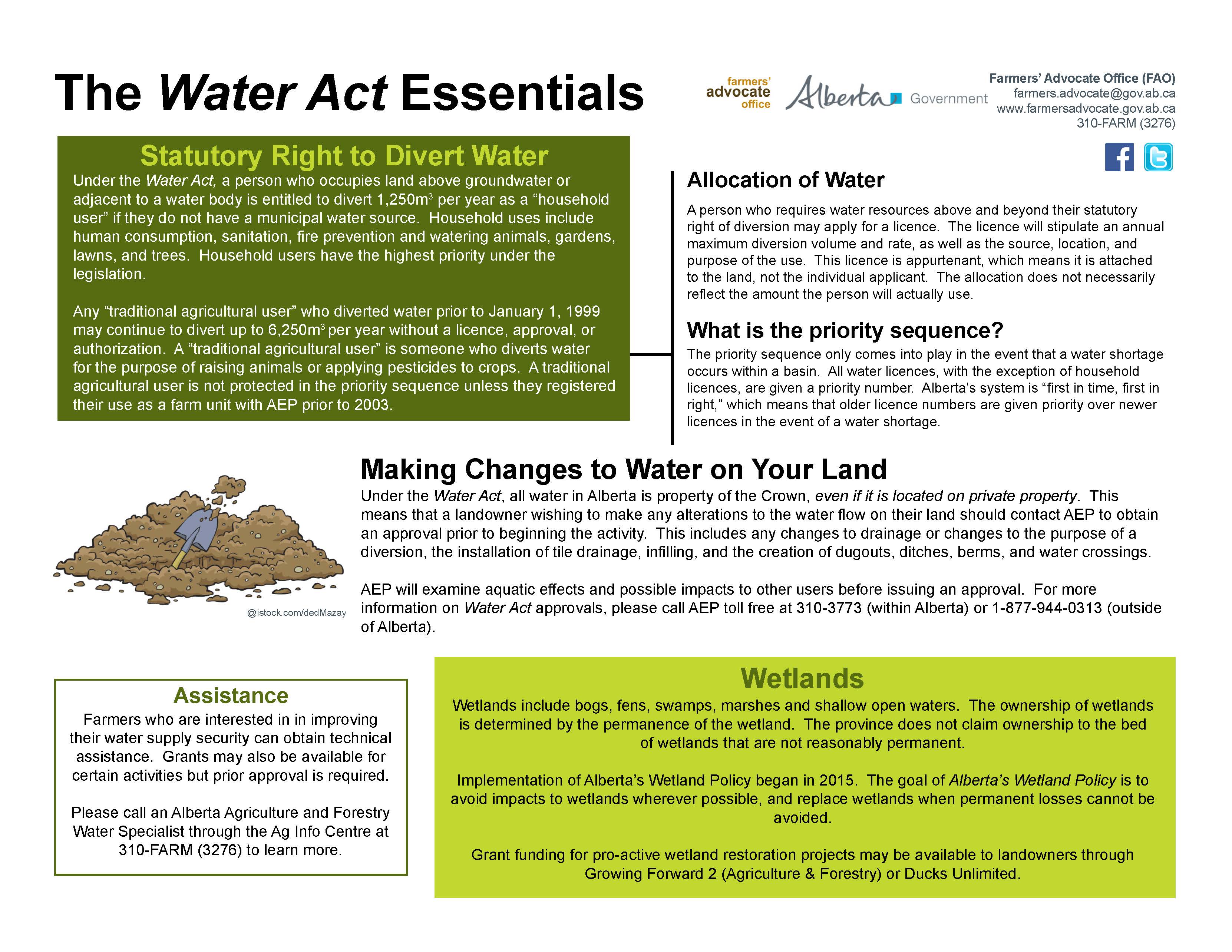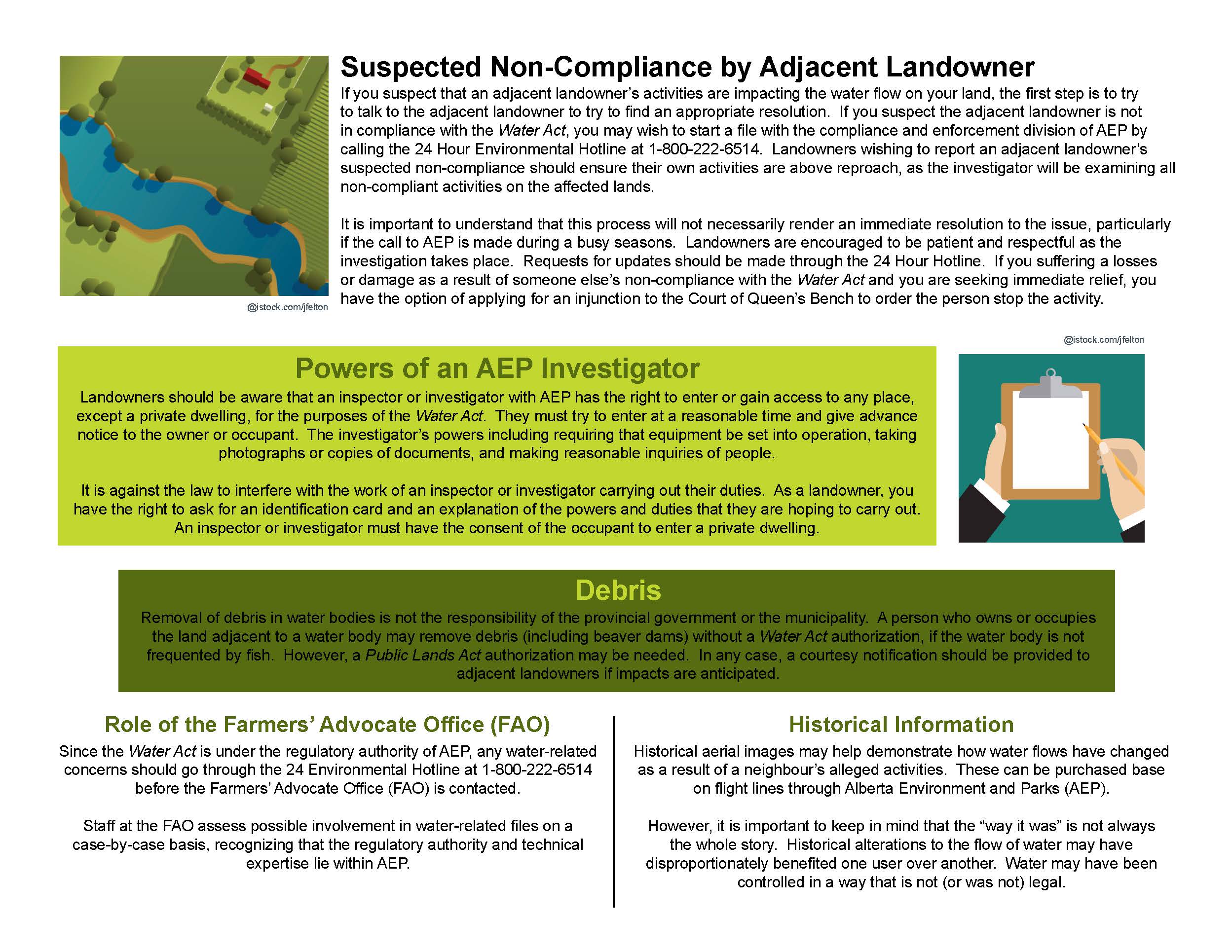| |  
CLICK HERE TO DOWNLOAD A PDF OF THE WATER ACT ESSENTIALS INFO GRAPHIC.
Making Changes to Water on Your Land
Under the Water Act, all water in Alberta is property of the Crown, even if it is located on private property. This means that a landowner wishing to make any alterations to the water flow on their land should contact AEP to obtain an approval prior to beginning the activity. This includes any changes to drainage or changes to the purpose of a diversion, the installation of tile drainage, infilling, and the creation of dugouts, ditches, berms, and water crossings.
AEP will examine aquatic effects and possible impacts to other users before issuing an approval. For more information on Water Act approvals, please call AEP toll free at 310-3773 (within Alberta) or 1-877-944-0313 (outside of Alberta).
Statutory Right to Divert Water
Under the Water Act, a person who occupies land above groundwater or adjacent to a water body is entitled to divert 1,250m3 per year as a “household user” if they do not have a municipal water source. Household uses include human consumption, sanitation, fire prevention and watering animals, gardens, lawns, and trees. Household users have the highest priority under the legislation.
Any “traditional agricultural user” who diverted water prior to January 1, 1999 may continue to divert up to 6,250m3 per year without a licence, approval, or authorization. A “traditional agricultural user” is someone who diverts water for the purpose of raising animals or applying pesticides to crops. A traditional agricultural user is not protected in the priority sequence unless they registered their use as a farm unit with AEP prior to 2003.
Allocation of Water & Priority Sequence
A person who requires water resources above and beyond their statutory right of diversion may apply for a licence. The licence will stipulate an annual maximum diversion volume and rate, as well as the source, location, and purpose of the use. This licence is appurtenant, which means it is attached to the land, not the individual applicant. The allocation does not necessarily reflect the amount the person will actually use.
The priority sequence only comes into play in the event that a water shortage occurs within a basin. All water licences, with the exception of household licences, are given a priority number. Alberta’s system is “first in time, first in right,” which means that older licence numbers are given priority over newer licences in the event of a water shortage.
Wetlands
Wetlands include bogs, fens, swamps, marshes and shallow open waters. Implementation of Alberta’s Wetland Policy began in 2015. The goal of Alberta’s Wetland Policy is to avoid impacts to wetlands wherever possible, and replace wetlands when permanent losses cannot be avoided. Grant funding for pro-active wetland restoration projects may be available to landowners through Growing Forward 2 (Agriculture & Forestry) or Ducks Unlimited.
Suspected Non-Compliance by Adjacent Landowner
If you suspect that an adjacent landowner’s activities are impacting the water flow on your land, the first step is to try to talk to the adjacent landowner to try to find an appropriate resolution. If you suspect the adjacent landowner is not in compliance with the Water Act, you may wish to start a file with the compliance and enforcement division of AEP by calling the 24 Hour Environmental Hotline at 1-800-222-6514. Landowners wishing to report an adjacent landowner’s suspected non-compliance should ensure their own activities are above reproach, as the investigator will be examining all non-compliant activities on the affected lands.
It is important to understand that this process will not necessarily render an immediate resolution to the issue, particularly if the call to AEP is made during a busy seasons. Landowners are encouraged to be patient and respectful as the investigation takes place. Requests for updates should be made through the 24 Hour Hotline. If you are suffering a losses or damage as a result of someone else’s non-compliance with the Water Act and you are seeking immediate relief, you have the option of applying for an injunction to the Court of Queen’s Bench to order the person stop the activity.
Powers of an Investigator
Landowners should be aware that an inspector or investigator with AEP has the right to enter or gain access to any place, except a private dwelling, for the purposes of the Water Act. They must try to enter at a reasonable time and give advance notice to the owner or occupant. The investigator’s powers including requiring that equipment be set into operation, taking photographs or copies of documents, and making reasonable inquiries of people.
It is against the law to interfere with the work of an inspector or investigator carrying out their duties. As a landowner, you have the right to ask for an identification card and an explanation of the powers and duties that they are hoping to carry out. An inspector or investigator must have the consent of the occupant to enter a private dwelling.
Historical Information
Historical aerial images may help demonstrate how water flows have changed as a result of a neighbour’s alleged activities. These can be purchased base on flight lines through Alberta Environment and Parks (AEP). However, it is important to keep in mind that the “way it was” is not always the whole story. Historical alterations to the flow of water may have disproportionately benefited one user over another. Water may have been controlled in a way that is not (or was not) legal.
Debris
Removal of debris in water bodies is not the responsibility of the provincial government or the municipality. A person who owns or occupies the land adjacent to a water body may remove debris (including beaver dams) without a Water Act authorization, if the water body is not frequented by fish. However, a Public Lands Act authorization may be needed. In any case, a courtesy notification should be provided to adjacent landowners if impacts are anticipated
Assistance – Improving Water Supply Security
Farmers who are interested in in improving their water supply security can obtain technical assistance. Grants may also be available for certain activities but prior approval is required. Please call an Alberta Agriculture and Forestry Water Specialist through the Ag Info Centre at 310-FARM (3276) to learn more.
Involvement of the FAO
Since the Water Act is under the regulatory authority of AEP, any water-related concerns should go through the 24 Environmental Hotline at 1-800-222-6514 before the Farmers’ Advocate Office (FAO) is contacted. Staff at the FAO assess possible involvement in water-related files on a case-by-case basis, recognizing that the regulatory authority and technical expertise lie within AEP.
Alberta Environment & Parks Information
Overview of the Water Act
Getting an Water Act Approval for Alterations to Water Flow
Guidelines for Licensing Water Diversion Projects
Temporary Water Diversion Licence
The Water Priority System in Alberta
Wetlands & Agriculture
Flood Prevention & Debris Removal
Dugouts
Search for Existing Water Act Authorization
Ownership of Beds & Shores on Naturally Occurring Lakes, Rivers, and Streams
Ordering Historical Aerial Photos
Please notify the FAO at farmers.advocate@gov.ab.ca if any of these links do not work.
PDF: Infographic
PDF: Printer-Friendly Version
|
|